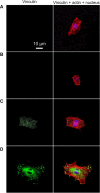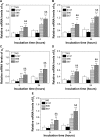Direct role of interrod spacing in mediating cell adhesion on Sr-HA nanorod-patterned coatings
- PMID: 24634585
- PMCID: PMC3952902
- DOI: 10.2147/IJN.S58236
Direct role of interrod spacing in mediating cell adhesion on Sr-HA nanorod-patterned coatings
Abstract
The process in which nanostructured surfaces mediate cell adhesion is not well understood, and may be indirect (via protein adsorption) or direct. We prepared Sr-doped hydroxyapatite (Sr1-HA) 3D nanorods (with interrod spacing of 67.3 ± 3.8, 95.7 ± 4.2, and 136.8 ± 8.7 nm) and 2D nanogranulate patterned coatings on titanium. Employing the coatings under the same surface chemistry and roughness, we investigated the indirect/direct role of Sr1-HA nanotopographies in the regulation of osteoblast adhesion in both serum-free and serum-containing Dulbecco's Modified Eagle/Ham's Medium. The results reveal that the number of adherent cells, cell-secreted anchoring proteins (fibronectin, vitronectin, and collagen), vinculin and focal adhesion kinase (FAK) denoted focal adhesion (FA) contact, and gene expression of vinculin, FAK, and integrin subunits (α2, α5, αv, β1, and β3), undergo significant changes in the inter-nanorod spacing and dimensionality of Sr1-HA nanotopographies in the absence of serum; they are significantly enhanced on the <96 nm spaced nanorods and more pronounced with decreasing interrod spacing. However, they are inhibited on the >96 nm spaced nanorods compared to nanogranulated 2D topography. Although the adsorption of fibronectin and vitronectin from serum are higher on 136.8 ± 8.7 nm spaced nanorod patterned topography than nanogranulated topography, cell adhesion is inhibited on the former compared to the latter in the presence of serum, further suggesting that reduced cell adhesion is independent of protein adsorption. It is clearly indicated that 3D nanotopography can directly modulate cell adhesion by regulating integrins, which subsequently mediate anchoring proteins' secretion and FA formation rather than via protein adsorption.
Keywords: anchoring protein secretion; focal adhesion; integrin; inter-nanorod spacing; nanotopography; osteoblast adhesion.
Figures








Similar articles
-
Regulation of osteoblast proliferation and differentiation by interrod spacing of Sr-HA nanorods on microporous titania coatings.ACS Appl Mater Interfaces. 2013 Jun 12;5(11):5358-65. doi: 10.1021/am401339n. Epub 2013 May 21. ACS Appl Mater Interfaces. 2013. PMID: 23668394
-
The osteogenic capacity of biomimetic hierarchical micropore/nanorod-patterned Sr-HA coatings with different interrod spacings.Nanomedicine. 2016 Jul;12(5):1161-73. doi: 10.1016/j.nano.2016.01.011. Epub 2016 Mar 4. Nanomedicine. 2016. PMID: 26961465
-
Effects of Nanotopography Regulation and Silicon Doping on Angiogenic and Osteogenic Activities of Hydroxyapatite Coating on Titanium Implant.Int J Nanomedicine. 2020 Jun 12;15:4171-4189. doi: 10.2147/IJN.S252936. eCollection 2020. Int J Nanomedicine. 2020. PMID: 32606671 Free PMC article.
-
Cell response of anodized nanotubes on titanium and titanium alloys.J Biomed Mater Res A. 2013 Sep;101(9):2726-39. doi: 10.1002/jbm.a.34575. Epub 2013 Feb 21. J Biomed Mater Res A. 2013. PMID: 23436766 Review.
-
Influence of substratum surface chemistry/energy and topography on the human fetal osteoblastic cell line hFOB 1.19: Phenotypic and genotypic responses observed in vitro.Biomaterials. 2007 Nov;28(31):4535-50. doi: 10.1016/j.biomaterials.2007.06.016. Epub 2007 Jul 20. Biomaterials. 2007. PMID: 17644175 Free PMC article. Review.
Cited by
-
Silver-nanoparticles-modified biomaterial surface resistant to staphylococcus: new insight into the antimicrobial action of silver.Sci Rep. 2016 Sep 7;6:32699. doi: 10.1038/srep32699. Sci Rep. 2016. PMID: 27599568 Free PMC article.
-
Gold Nanorod Substrate for Rat Fetal Neural Stem Cell Differentiation into Oligodendrocytes.Nanomaterials (Basel). 2022 Mar 11;12(6):929. doi: 10.3390/nano12060929. Nanomaterials (Basel). 2022. PMID: 35335742 Free PMC article.
-
Eco-friendly bacteria-killing by nanorods through mechano-puncture with top selectivity.Bioact Mater. 2021 Dec 21;15:173-184. doi: 10.1016/j.bioactmat.2021.11.028. eCollection 2022 Sep. Bioact Mater. 2021. PMID: 35386355 Free PMC article.
-
Lateral Spacing of TiO2 Nanotubes Modulates Osteoblast Behavior.Materials (Basel). 2019 Sep 12;12(18):2956. doi: 10.3390/ma12182956. Materials (Basel). 2019. PMID: 31547276 Free PMC article.
-
Participation of integrin β3 in osteoblast differentiation induced by titanium with nano or microtopography.J Biomed Mater Res A. 2019 Jun;107(6):1303-1313. doi: 10.1002/jbm.a.36643. Epub 2019 Feb 23. J Biomed Mater Res A. 2019. PMID: 30707485 Free PMC article.
References
-
- Anselme K. Osteoblast adhesion on biomaterials. Biomaterials. 2000;21(7):667–681. - PubMed
-
- Geiger B, Spatz JP, Bershadsky AD. Environmental sensing through focal adhesions. Nat Rev Mol Cell Biol. 2009;10(1):21–33. - PubMed
-
- Geiger B, Bershadsky A, Pankov R, Yamada KM. Transmembrane crosstalk between the extracellular matrix and the cytoskeleton. Nat Rev Mol Cell Biol. 2001;2(11):793–805. - PubMed
-
- Hynes RO. Integrins: bidirectional, allosteric signaling machines. Cell. 2002;110(6):673–687. - PubMed
Publication types
MeSH terms
Substances
LinkOut - more resources
Full Text Sources
Other Literature Sources
Molecular Biology Databases
Research Materials
Miscellaneous

